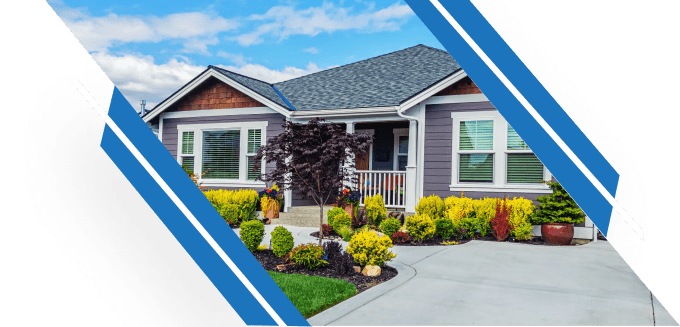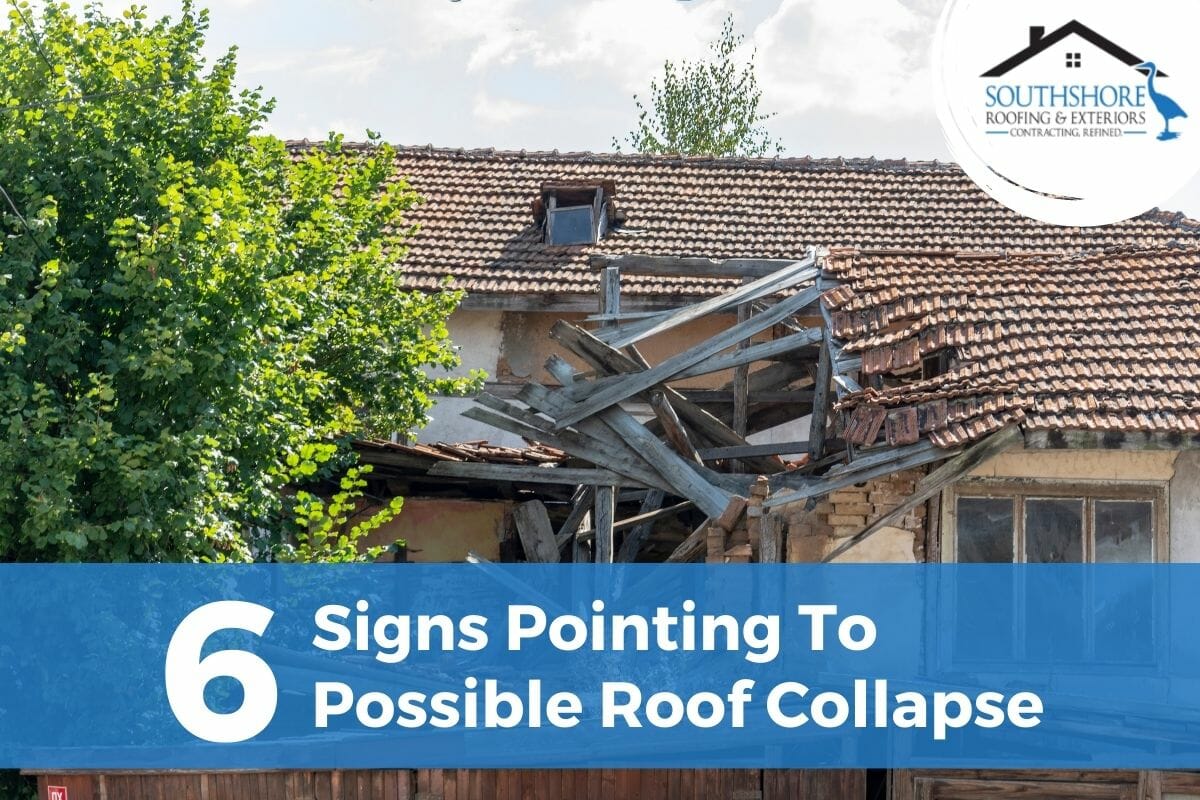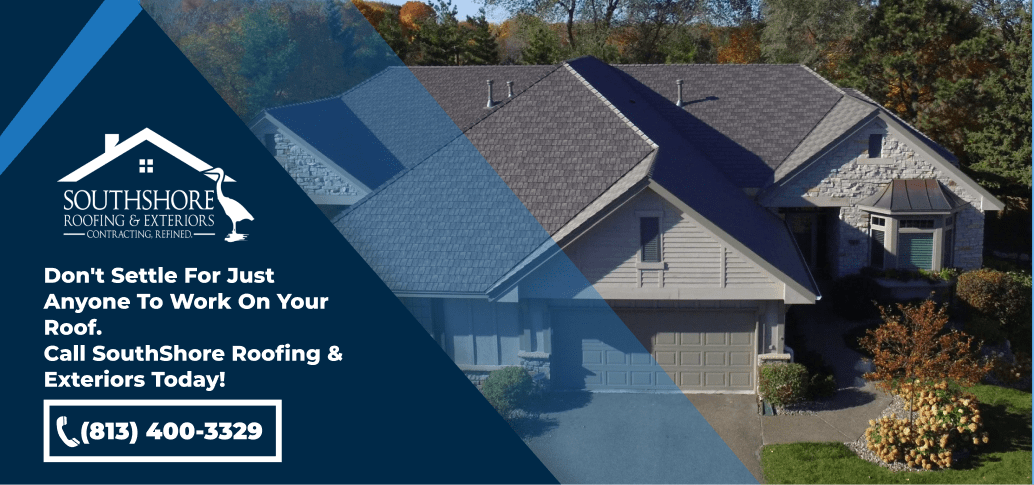A strong, stable roof safeguards you and your family from the unpredictable forces of nature. Imagine waking up one day to the sound of cracking and crashing as your roof collapses, causing havoc and endangering everyone inside. It’s a nightmare scenario that no homeowner wants to face.
Understanding the warning signs of a potential roof collapse is essential for ensuring the safety and security of your home. By recognizing these indicators early on, you can take proactive measures to prevent that catastrophic event. In this blog post, we will explore six critical signs that point to a possible roof collapse, enabling you to act swiftly and protect your property.
#1 Damaged Roof Shingles Or Other Roofing Materials
Your roofing system is covered with some kind of protective material. There are several types, but they all play a vital role in providing shelter and structural integrity. However, when these materials start showing signs of damage, it could be an indication of an impending roof collapse. Here are some key warning signs to look out for:
Cracked or Curling Shingles:
Inspect your roof for shingles that are cracked, split, or curling at the edges. These issues can weaken the overall structure and compromise the roof’s ability to withstand external forces like wind, rain, and snow.
Missing or Loose Shingles:
If you notice any missing shingles or ones that are hanging loosely, it’s a clear sign that your roof is vulnerable. Missing shingles create gaps that allow water to seep through, potentially leading to water damage and further deterioration of the roof.
Granule Loss:
Check your gutters and downspouts for large amounts of granules. Shingles naturally shed granules over time, but an excessive accumulation in the gutters indicates accelerated wear and aging of the roof. This loss of granules compromises the shingle’s protective properties and exposes the underlying layers to potential damage.
#2 Sagging Roof
A sagging or drooping roof is not only an eyesore but also a significant warning sign of potential structural damage. A sagging roof structure is one of the major signals that the integrity of your roof has been compromised, and immediate attention is necessary to prevent further issues.
A sagging or drooping roof often suggests that the supporting structures beneath it, such as rafters or trusses, have weakened or are damaged. This happens because of several reasons, including the following:
- Excessive weight on the roof
- Inadequate structural design
- Water damage
- Age-related deterioration
Over time, the weight of the roof itself, coupled with external forces like wind or heavy snow, can exacerbate the problem, leading to a partial or complete roof collapse.
Roof sag, during the initial stages, may not be easy to spot as the movement is usually fairly slow until it is too late. This is why you need to inspect your roofing system regularly, including your rafters/trusses. Look out for uneven lines along the roof’s surface, where it appears to dip or sag in specific areas. Visibly bowed or sagging sections, especially in comparison to the rest of the roof, are clear indicators of underlying structural issues.
#3 Cracks In The Ceiling
In addition to observing signs of a collapsing roofing system from the outside, it’s important to be aware of indicators that are visible from inside the home as well.
When the structural integrity of your roof is compromised, it can lead to shifts and movements in the walls and ceilings of your home. As a result, cracks may start to appear, particularly near the upper portions of walls or along the ceiling.
What most homeowners do, and what you should avoid, is underestimating the problem. In most cases, you are likely to think that this is due to the aging of the home. It’s easy to dismiss these cracks as mere signs of the home’s natural wear and tear. After all, houses settle and go through changes over time. While it’s true that aging can contribute to the appearance of cracks, when they start to appear on the ceiling area, it’s crucial to be attentive and proactive.
These cracks may be small at first but can widen over time and can signal several underlying issues such as weakened support structures or compromised materials. These signs can ultimately result in a collapsed roof.
#4 A Leaky Roof
As a homeowner, one of the biggest headaches can be a leaking roof. Water stains or leaks within your home are not only unsightly but also serve as a red flag for potential roof collapse. The connection between water stains or leaks and roof integrity is crucial to understand in order to protect your home.
Prolonged exposure to water can gradually weaken the structure of your roof. When water penetrates through damaged or compromised areas, it seeps into the underlying layers, including the roof deck, insulation, and support structures. Over time, this constant moisture leads to rot, decay, and deterioration of these essential components, compromising the overall stability of the roof.
If you notice water stains or experience leaks in your home, it is important to address them promptly.
#5 Doors Not Working As Usual
Many of you might think: what do doors have to do with a potential roof collapse? But your doors and windows can signal whether there is something wrong with your roofing system. In one of the above points, we covered how a sagging roof is a crucial sign. When the roof sags, it puts pressure on your home’s interior, including the doors.
When a roof experiences architectural damage, it can cause shifts and misalignments in the overall structure of your home. This can manifest in the form of doors and windows that no longer open and close smoothly. You may notice difficulty in latching or aligning doors, or windows that stick or jam when attempting to open or close them.
Both the doors and the window system of your home are perfectly sealed at the time of installation so there is no chance of water intrusion and air leaks. A drooping roof will start to press against the top of the doors, especially the ones located on the interior. This can cause them to warp or become misaligned.
If you notice these issues persisting or becoming more pronounced over time, it is crucial to have your roof inspected by a professional.
#6 Unusual Sounds In The Attic
The last sign of potential roof collapse that we will discuss today is unusual sounds in the attic area. The attic is located right below your roofing system, so it is one of the most important areas to look after.
When there is damage or weakness in a roof, you may hear strange sounds coming from the attic. These noises can include creaking, cracking, or popping sounds. They occur as a result of the compromised integrity of the roof’s components, such as rafters, trusses, or supporting beams. The weight and pressure on the weakened elements can cause them to shift, leading to the noises you may hear.
As a homeowner, you should be attentive to any new or unusual sounds coming from the attic. These sounds should never be disregarded, as they often signal potential problems with your roof’s structure.
The Role Maintenance Plays In Preventing Roof Collapse
Regular roof maintenance is a crucial step in safeguarding your home and preventing the potential risks of roof collapse. By prioritizing routine inspections and maintenance, you can ensure the longevity, stability, and safety of your roof, and the well-being of everyone in the home. Here is how being more proactive can help you in the long run:
- Early detection: Regular inspections catch potential issues early, preventing them from escalating into major problems.
- Mitigating damage: Addressing minor repairs promptly prevents significant damage and costly repairs or replacements.
- Extending lifespan: Proper maintenance extends your roof’s lifespan, delaying the need for premature replacement.
- Weather readiness: Well-maintained roofs can better withstand extreme weather conditions, protecting your home.
- Peace of mind: Regular maintenance provides reassurance and reduces concerns about structural issues.
All these tips we have shared can help you manage your home and your roof. However, to get an even better understanding of your roof it is important to get in touch with a contractor.
Learn More: How You Can Keep Your Home Safe During Vacation
Roof Collapse Prevention Starts Here: Contact Our Knowledgeable Roofing Professionals
Don’t wait for disaster to strike. Take action today and reach out to our professional roofing team to schedule a comprehensive free roof inspection, or to address any concerns you may have.
Here at SouthShore Roofing & Exteriors, we have been offering the best residential roofing services in Tampa for years. Our experienced contractors will provide the necessary expertise, recommendations, and services to ensure the structural integrity of your roof and the safety of your home. You can contact us today at (813) 400-3329 and we will be happy to help you.




